
Do you have a question about the MSI Z370 GAMING PRO CARBON and is the answer not in the manual?
| ECC | No |
|---|---|
| Non-ECC | Yes |
| Memory channels | Dual-channel |
| Memory slots type | DIMM |
| Number of memory slots | 4 |
| Supported memory types | DDR4-SDRAM |
| Maximum internal memory | 64 GB |
| Supported memory clock speeds | 2133, 4000 MHz |
| Audio chip | Realtek ALC1220 |
| Cooling type | Passive |
| Component for | PC |
| Motherboard chipset | Intel® Z370 |
| PC health monitoring | CPU, FAN, Power supply, Temperature, Voltage |
| Audio output channels | 7.1 channels |
| Motherboard form factor | ATX |
| Motherboard chipset family | Intel |
| RAID levels | 0, 1, 5, 10 |
| Supported storage drive types | HDD & SSD |
| Supported storage drive interfaces | M.2, SATA III |
| Parallel processing technology support | 2-Way CrossFireX, 2-Way SLI, 3-Way CrossFireX |
| Processor socket | LGA 1151 (Socket H4) |
| Compatible processor series | Intel Celeron, Intel Pentium |
| Maximum number of SMP processors | 1 |
| Number of M.2 (M) slots | 2 |
| PCI Express x1 (Gen 3.x) slots | 3 |
| BIOS type | UEFI |
| Cables included | SATA |
| LAN controller | Intel® I219-V |
| Ethernet interface type | Gigabit Ethernet |
| Number of SATA connectors | 6 |
| Number of Parallel ATA connectors | 0 |
| USB 2.0 ports quantity | USB 2.0 ports have a data transmission speed of 480 Mbps, and are backwards compatible with USB 1.1 ports. You can connect all kinds of peripheral devices to them. |
| Depth | - mm |
|---|---|
| Width | 243 mm |
| Height | 304 mm |
Lists all items included in the motherboard package such as manuals, cables, and accessories.
Instructions to prevent damage from static electricity during assembly.
Advice on handling, storing, and avoiding damage to the motherboard.
Guidelines for safe power connection and environmental conditions.
Lists essential tools and components for system assembly.
Details on CPU, chipset, memory capacity, and expansion slot types.
Specs for onboard graphics, multi-GPU support, and storage interfaces.
Specifications for RAID, USB ports, audio, LAN, and wireless connectivity.
Lists back panel and internal connectors, I/O controller, and hardware monitor.
Motherboard dimensions, BIOS features, and list of supported software.
Covers audio, network, fan, LED, protection, and performance enhancement features.
Explains the status indicators for the LAN port LEDs.
Diagram showing audio port assignments for different channel setups.
Describes the dialog for detecting and identifying connected audio devices.
Identifies CPU Socket, DIMM slots, and PCIe expansion slots.
Details M.2, SATA, USB ports, and front panel connectors.
Identifies power, fan, audio, TPM, CMOS, and RGB connectors.
Crucial advice for CPU installation, including alignment and heatsink mounting.
Guidance on installing memory, OS compatibility, and BIOS settings.
Advice on installing multiple GPUs for optimal performance and slot usage.
Slot recommendations, and step-by-step guide for setting up SLI.
Emphasizes ensuring all cables are properly connected for the Wi-Fi card.
Details M.2 slot readiness and steps for installing modules and shields.
Advice on SATA cables and possible M.2/SATA slot combinations.
Ensures secure connection of power cables for stable motherboard operation.
Importance of correct VCC and Ground pin connection for USB 2.0.
Importance of correct Power and Ground pin connection for USB 3.1 Gen1.
Explains PWM/DC modes and pin assignments for fan connectors.
How to change fan mode and speed via BIOS settings.
Steps to enable and reset chassis intrusion detection functionality.
Procedure to reset BIOS settings using the Clear CMOS jumper.
Warning about connecting incorrect voltage LED strips to avoid damage.
Explains the function of motherboard LEDs for debugging and status.
Indicates memory installation and components for LED effect demonstrations.
Methods to access BIOS and reference for function keys.
Procedures for resetting BIOS and updating via M-FLASH or Live Update 6.
Basic system info and settings adjustment in EZ Mode.
Cautions and explanations of EZ Mode features.
Details on information displays and function buttons in EZ Mode.
Navigating Advanced Mode and available BIOS menu options.
Displays system date, time, SATA/M.2 info, system info, and DMI info.
Configuration for PCI and PCI express settings.
Settings for PCIe link speed, latency, and power LED behavior.
Settings for onboard peripherals like LAN, HDD, USB, Audio.
SATA controller mode and M.2/Optane Genie configurations.
Adjusts integrated graphics settings and display options.
Configures USB controller functions and system power management.
Detailed Windows OS configuration and behaviors.
Settings for Windows 10 support, fast boot, and secure boot.
Configures system wake-up behaviors from various events.
Resume from keyboard/mouse, boot options, logo display, and boot mode selection.
Manages administrator/user passwords and TPM functions.
Selects TPM device and configures chassis intrusion detection.
Options to discard changes, save, restore defaults, and override boot devices.
Cautions on overclocking risks and explanations of OC explore modes.
Adjusts CPU ratio and core ratio limits for performance tuning.
Configures CPU ratio modes, offsets, ring ratio, and GT ratio.
Manages CPU features like EIST, Turbo Boost, and Enhanced Turbo.
Adjusts CPU base clock and memory profiles (XMP, DRAM frequency).
Sets DRAM timing modes and advanced memory configurations.
Controls CPU/GT voltage protection, current, and loadline calibration.
Configures CPU GT frequency, voltages, and memory change detection.
Displays CPU specs and sets OC quick view timer duration.
Details CPU technology support and features like Hyper-Threading.
Settings for cache prefetch, AES, thermal monitor, and C-states.
Manages Turbo Boost and power limits for CPU performance.
Step-by-step guide to update BIOS using a USB flash drive.
Manages overclocking profiles and save/load from USB/ROM.
Monitors temps, speeds, voltages, and manages fan settings.
Guides for installing the operating system, drivers, and utilities.
Manages MSI applications and notes on simultaneous uninstallation.
Steps to update the system using Live Update 6.
Simplifies frequent installation procedures with a single click.
Manages system settings and monitors status with profile options.
Adjust CPU Ratio and Base clock, view core frequencies.
Manages CPU fan, voltage, DRAM, and integrated graphics settings.
Adjusts Voltage, Fan, DRAM, and monitors system status.
Monitors system status, sets warnings, and enables mobile control.
Controls system for gaming performance and manages gaming functions.
Links android device to motherboard for remote control.
Configures on-screen display information and optimizes display settings.
Enables/disables VR settings and closes applications for better VR.
Manages hotkeys and toggles between categories like Macro Genie.
Notes on keys that cannot be used as hotkeys and customization.
Provides mouse macro functions, DPI adjustment, and control explanations.
Selects system performance modes for system environment.
Enables USB UP, STORAGE BOOST, VR BOOST; only one mode selectable.
Configures synchronized LED effects and manages sync profiles.
Configures LED light effects specifically for the motherboard.
Creates Windows USB drives and software RAID.
Steps to create software RAID and notes on system disk exclusion.
Steps to create a virtual RAM disk and manage its settings.
Manages network traffic and configures bandwidth via Network Test.
Optimizes bandwidth usage by testing upload and download speeds.
Watch game streams and adjust display/hotkey settings.
Accesses audio effects, profiles, and settings for enhanced audio experience.
Selects EQ profiles and configures microphone effects.
HD audio recording and streamer audio launchpad features.
Visual indicator for sound localization in FPS games.
Platform for SteelSeries products and device configuration management.
Customizes device settings using widgets and explains tooltips.
Navigates functions, controls settings, and monitors system values.
Explains CPU, Caches, Mainboard, Memory, SPD, Graphics, Bench, About tabs.
Plays PC games in 3D on a VR headset and navigates the VR environment.
Lists supported games and modifies virtual screen settings.
Adjusts screen, game, and advanced settings including audio and quality.
Integrates SmartCam for background replacement and configures modes/quality.
Compares RAID levels and guides entering Intel RST Option ROM.
Step-by-step guide to create a RAID volume with sizing advice.
Procedures to delete RAID volumes and revert disks to non-RAID.
Sets recovery modes and explains handling of degraded RAID arrays.
Procedure for replacing a failed hard drive in a RAID array.
Methods for creating M.2 RAID and notes on system compatibility.
Detailed steps for creating a RAID volume within Intel RST.
Procedures for removing M.2 RAID using M.2/Optane Genie or UEFI BIOS.
Lists requirements and steps for installing Optane memory.
Activates Optane memory and provides critical warnings to prevent OS damage.
Disables Optane memory and M.2/Optane Genie in BIOS.
Uses MSI SMART TOOL to disable Optane and revert SATA to AHCI.
Addresses common hardware and connectivity problems.
Compliance statements for FCC, CE, C-Tick, and battery disposal.
Information on chemical substances and environmental disposal guidelines.
EU directive on Waste Electrical and Electronic Equipment.
Environmental compliance statements in various languages.
Compliance statements for Japan, India, Turkey, Ukraine, Vietnam.
Information on copyright, trademarks, and MSI support resources.
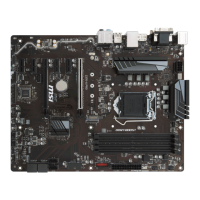

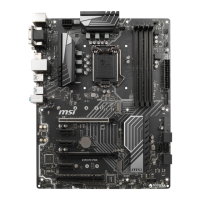


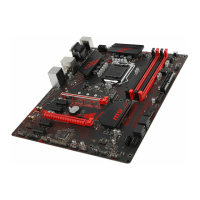
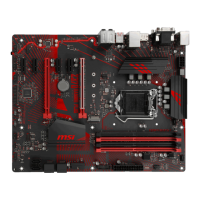


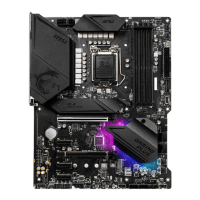
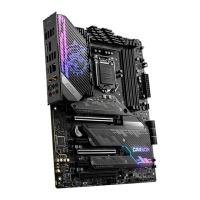
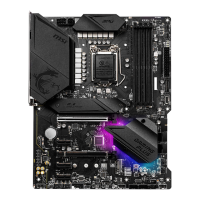
